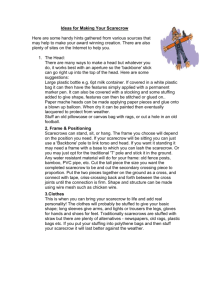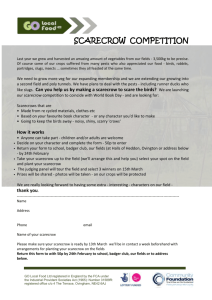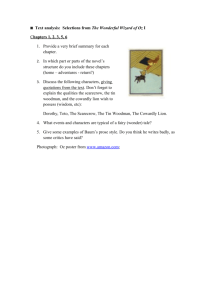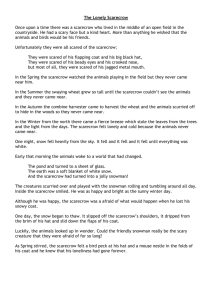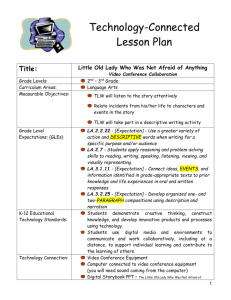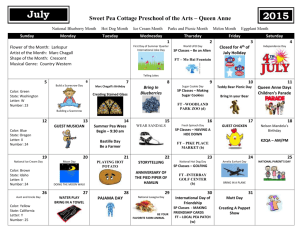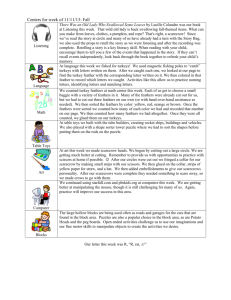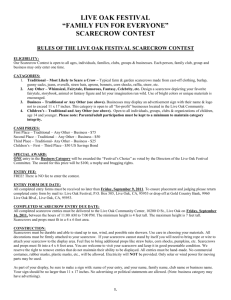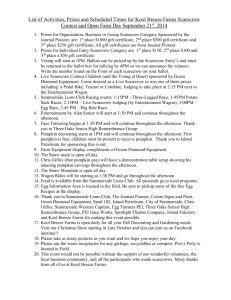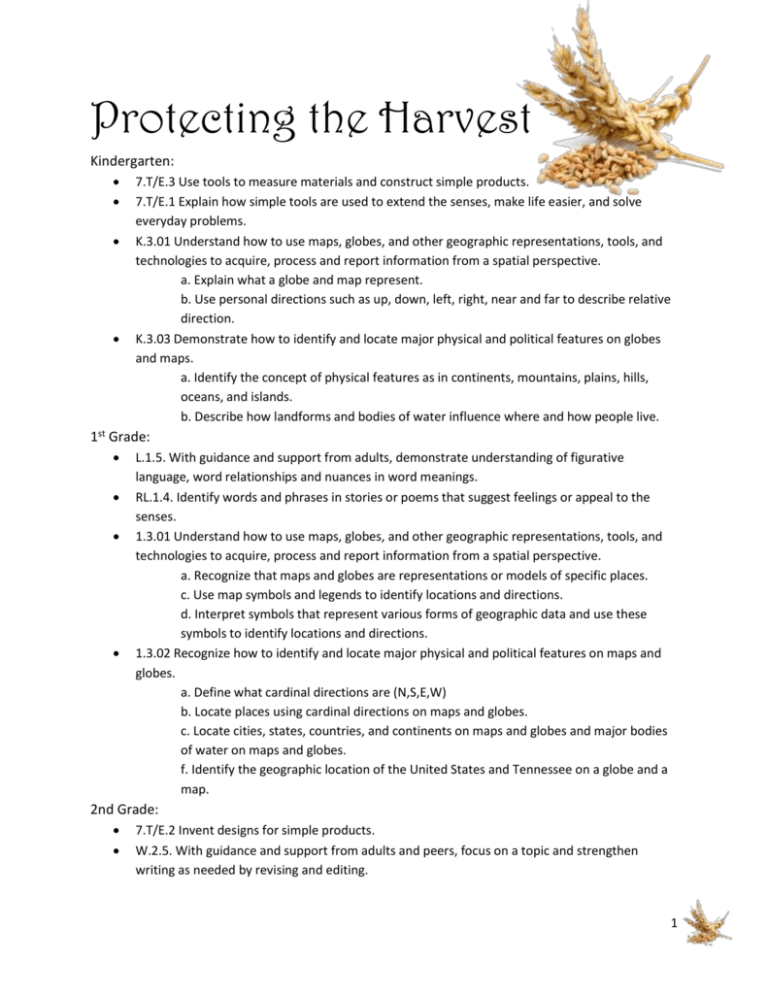
Protecting the Harvest
Kindergarten:
7.T/E.3 Use tools to measure materials and construct simple products.
7.T/E.1 Explain how simple tools are used to extend the senses, make life easier, and solve
everyday problems.
K.3.01 Understand how to use maps, globes, and other geographic representations, tools, and
technologies to acquire, process and report information from a spatial perspective.
a. Explain what a globe and map represent.
b. Use personal directions such as up, down, left, right, near and far to describe relative
direction.
K.3.03 Demonstrate how to identify and locate major physical and political features on globes
and maps.
a. Identify the concept of physical features as in continents, mountains, plains, hills,
oceans, and islands.
b. Describe how landforms and bodies of water influence where and how people live.
1st Grade:
L.1.5. With guidance and support from adults, demonstrate understanding of figurative
language, word relationships and nuances in word meanings.
RL.1.4. Identify words and phrases in stories or poems that suggest feelings or appeal to the
senses.
1.3.01 Understand how to use maps, globes, and other geographic representations, tools, and
technologies to acquire, process and report information from a spatial perspective.
a. Recognize that maps and globes are representations or models of specific places.
c. Use map symbols and legends to identify locations and directions.
d. Interpret symbols that represent various forms of geographic data and use these
symbols to identify locations and directions.
1.3.02 Recognize how to identify and locate major physical and political features on maps and
globes.
a. Define what cardinal directions are (N,S,E,W)
b. Locate places using cardinal directions on maps and globes.
c. Locate cities, states, countries, and continents on maps and globes and major bodies
of water on maps and globes.
f. Identify the geographic location of the United States and Tennessee on a globe and a
map.
2nd Grade:
7.T/E.2 Invent designs for simple products.
W.2.5. With guidance and support from adults and peers, focus on a topic and strengthen
writing as needed by revising and editing.
1
RI.2.3. Describe the connection between a series of historical events, scientific ideas or
concepts.
L.2.5. Demonstrate understanding of figurative language, word relationships and identify reallife connections between words and their use
2.3.01 Understand how to use maps, globes, and other geographic representations, tools, and
technologies to acquire, process and report information from a spatial perspective.
a. Describe how the globe is a model of earth locating hemispheres, poles, and equator.
b. Recognize that natural regions are represented on different types of maps by showing
physical features, climate, vegetation, and natural resources.
c. Subdivide the world by positioning the equator, continents, oceans, and hemispheres
on a map and globe.
d. Recognize that a map contains elements such as title, scale, symbols, legends, grids,
cardinal and intermediate direction."
2.3.02 Recognize the interaction between human and physical systems around the world.
a. Analyze how individuals and populations depend upon land resources.
2.3.03 Demonstrate how to identify and locate major physical and political features on globes
and maps.
a. Show how landmasses and bodies of water are represented on maps and globes.
3rd Grade:
L.3.3. Use knowledge of language and its conventions when writing, speaking, reading, or
listening. Choose words and phrases for effect.
W.3.5. With guidance and support from peers and adults, develop and strengthen writing as
needed by planning, revising, and editing.
SPI 7.T/E.1 Select a tool, technology, or invention that was used to solve a human problem.
3.3.01 Understand how to use maps, globes, and other geographic representations, tools, and
technologies to acquire, process and report information from a spatial perspective.
c. Locate places on a map using cardinal and intermediate direction.
3.3.02 Recognize the interaction between human and physical systems around the world.
3.3.03 Demonstrate how to identify and locate major physical and political features on globes
and maps.
4th Grade:
RI.4.3. Explain events, procedures, ideas, or concepts in a historical, scientific, or technical
context, including what happened and why.
L.4.3. Use knowledge of language and its conventions when writing, speaking, reading, or
listening. Choose words and phrases to convey ideas precisely and choose punctuation for
effect.
W.4.7. Conduct/participate in short research projects that build knowledge through
investigation of different aspects of a topic.
4.3.01 Understand how to use maps, globes, and other geographic representations, tools, and
technologies to acquire, process and report information from a spatial perspective.
a. Locate major countries of the world on a map or globe…
2
b. Locate places on a map using cardinal and intermediate directions, latitude and
longitude, and time zones.
4.3.03 Understand how to identify and locate major physical and political features on globes and
maps.
5th Grade:
W.5.5. With guidance and support from peers and adults, develop and strengthen writing as
needed by planning, revising, editing, rewriting, or trying a new approach.
L.5.3. Use knowledge of language and its conventions when writing, speaking, reading, or
listening. Expand, combine, and reduce sentences for meaning, reader/listener interest, and
style. Compare and contrast the varieties of English used in stories or poems.
W.5.7. Conduct/participate in short research projects that use several sources to build
knowledge through investigation of different aspects of a topic.
5.3.01 Understand how to use maps, globes, and other geographic representations, tools, and
technologies to acquire, process and report information from a spatial perspective.
5.3.02 Recognize the interaction between human and physical systems around the world.
5.3.03 Demonstrate how to identify and locate major physical and political features on globes
and maps.
6th Grade:
7th
SPI 7.T/E.1 Identify the tools and procedures needed to test the design features of a prototype.
RI.6.7. Integrate information presented and gained through different media or formats (e.g.,
visually, quantitatively, kinesthetically) as well as in words to develop a coherent understanding
of a topic.
7.T/E.5 Develop an adaptive design and test its effectiveness.
6.3.01 Understand the characteristics and uses of maps.
a. Use the basic elements of maps and mapping.
b. Identify the locations of certain physical and human features and events on maps and
globes.
6.3.02 Know the location of places and geographic features, both physical and human.
Grade:
7.T/E.5 Develop an adaptive design and test its effectiveness.
L.7.2. Demonstrate command of the conventions of standard English capitalization, punctuation,
and spelling when writing.
7.T/E.2 Apply the engineering design process to construct a prototype that meets certain
specifications.
7.3.01 Understand the characteristics and uses of maps, globes, and other geographic tools and
technologies.
a. Identify, describe, and be able to use the basic elements of maps and mapping.
b. Identify the location of physical and human attributes on maps and globes at local,
regional, and/or global scales.
7.3.02 Know the location of places and geographic features, both physical and human, locally,
regionally and globally.
3
a. Identify the location of Earth's major physical characteristics such as continents,
landforms, bodies of water, climate regions, vegetation, and natural resources.
7.3.03 Understand the characteristics and uses of spatial organization of Earth's surface.
7.3.04 Understand the physical and human characteristics of place.
7.3.07 Understand how physical systems and the physical environment affect human systems.
a. Describe how the characteristics of different physical environments affect human
activities including ways in which people adapt to living in different physical
environments.
b. Describe the impact and interaction of natural hazards and disasters on human
settlements and systems.
8th Grade:
7.T/E.5 Develop an adaptive design and test its effectiveness.
7.T/E.1 Use appropriate tools to test for strength, hardness, and flexibility of materials.
RST.6-8.9. Compare and contrast the information gained from experiments, simulations, video,
or multimedia sources with that gained from a text on the same topic.
8.3.01 Understand how to use maps, globes, and other geographic representations, tools, and
technologies to acquire, process, and report information from a spatial perspective.
a. Locate major countries and regions of the world on a map or globe.
8.3.03 Recognize the interaction between human and physical systems.
c. Describe how geographic features affect the development of transportation and
communication networks.
d. Explain the influences of geographic features both physical and human on historical
events.
High School:
W.9-10.5. Develop and strengthen writing as needed by planning, revising, editing, rewriting, or
trying a new approach, focusing on addressing what is most significant for a specific purpose
and audience.
L.9-10.5. Demonstrate understanding of figurative language, word relationships, and nuances in
word meanings.
3.1 understand the characteristics and uses of maps, globes, and other geographic tools and
technologies and construct maps and other geographic representations using primary data.
3.2 know the location of places, geographic features, and patterns of the environment, both
physical and human, locally, regionally, and globally.
3.3 Understand the characteristics and uses of spatial organization of Earth’s surface.
Examples of Possible Academic Vocabulary to Incorporate in this lesson:
Chosen vocabulary must consist of words that naturally and easily fit within the theme and
framework of the lesson. Look at the words below and choose as many as possible that
your students may not be familiar with, which naturally fit within the structure of your
4
lesson. The more words we can introduce in a setting that makes sense to our students, the
better.
Kindergarten:
Beginning
Ending
Read
Drawing
Tools
st
1 Grade
Sequence
Predict
Property
Push
Pull
Investigate
nd
2 Grade
Energy
Investigate
Observation
Similarities/Differences
rd
3 Grade
Physical change
Force
Tools
Cause
Effect
th
4 Grade
Energy
Probability
Convert
Proofread
th
5 Grade
Theme
Punctuation marks
States of Matter
th
6 Grade
Cause and Effect
Criteria
Design Constraint
Prototype
Observe
Poem
Rhyme
Position
Order
History
Past
Present
Future
Balance
Pre-write
Draft
Edit
Dimensions
Punctuation
Synonym
Antonym
Verb
Prediction
Compare
Contrast
Formula
Volume
Rhyme
Rhythm
Similarity
Simulation
5
7th Grade
Impact
Property
th
8 Grade
Density
Inductive & Deductive Reasoning
Sequence
Human Impact
Proportional relationships
Function
Elements of Design
Reasoning
Revision
Efficiency
6
Protecting
the Harvest
Access Prior Knowledge:
There are many excellent
resources available that can
serve to introduce the
subject matter, for example, there are books such as The Scarecrow’s Hat, or show the lovely Oscar
Nominated Short Film, The Legend of the Scarecrow/La Leyenda del Espantapajaros, in which the life of
a scarecrow changes when he decides to become friends with the birds. This short film has been
internationally acclaimed and received numerous awards since its premiere (including a pre-selection to
the Oscars). You can find the film at http://vimeo.com/811761,
http://www.carloslascano.com/carloslascano/vid_espanta.html. The story translated into English, has
been included at the end of the lesson. For English speaking students you may want to introduce the
story first and before watching the film (which is in Spanish), to increase comprehension. Note: ALWAYS
watch any video yourself before showing it to your class to gauge it’s appropriateness for your
classroom and your students. You, after all, know them best.
After the story/video, discuss with students the ramifications of perception, how did that affect each
character? The scarecrow, the birds, and the farmer? How did each perceive the others? Read the
R/LA standards for your grade levels and make the discussion appropriate for the skills students need
to practice.
The Legend of the Scarecrow [La Leyenda del Espantapajaros]
Once upon a time, there was a scarecrow who
had no friends. He worked in a wheat field and
the work was not hard, but it was very lonely.
Days and nights passed by and the scarecrow had
no one to talk to. The only thing he could do was
to look at the birds. Each time they flew by, he´d
wave at them, but they would never answer him.
They flew away as if they were afraid of him. One
day, the scarecrow did something forbidden and
offered the birds some seeds, but the birds only flew away. The lonely scarecrow wondered why no-one
wanted to be his friend.
7
And so time went by till, one cold night, a blind purple crow fell at his feet. The crow was shivering and
starving to death and the lonely scarecrow decided to take care of him. After several days, the blind
crow began to get better. As he held him close, the scarecrow told the crow how he had wrapped him in
his soft scarf, stroked his purple feathers until they became smooth, and gave him seeds to eat.
Before the crow flew away the scarecrow asked why the birds never wanted to be friend with the
scarecrows. And the crow explained that the job of the scarecrows was to scare the poor birds who only
wanted to eat. “Scarecrows are evil and despicable… they are monsters!” said the bird. Humiliated, the
scarecrow replied: “It´s not true! Take me, for example. I’m not evil, and I’m a scarecrow.” But the
crow flew away, and once more, the scarecrow was left with no friends.
That same night, that scarecrow made a decision, he wanted another job and no longer wanted to
frighten birds. Gathering his courage, the scarecrow went to the farmer’s house and woke up the
farmer. Seeing his scarecrow talking, the farmer screamed. Terrified, the farmer woke up all his
neighbors and told everyone that his scarecrow had come to life and that he was going to harm them.
The neighbors chased the frightened scarecrow across the fields until he found an old windmill to hide
in. Climbing the stairs to escape the angry people, he at last reached the top, but could not escape the
flames the people had lit.
The scarecrow screamed in pain and fear, crying for help but nobody heard, or cared, except for a few
beautiful purple crows flying around. One of them was the blind crow. Asking what was happening, his
friends told him that the villagers were burning down an old windmill where a scarecrow with a very
long scarf was trying to hide. The blind crow knew it was the kind scarecrow who once had saved his life
and quickly told the others his story. Touched by the tale of the scarecrow’s kindness, the crows longed
to save the scarecrow and flew close, but it was too late, the fire’s heat raged too hot, and they could
only watch as the lonely scarecrow burned and died.
The crows waited until dawn, and when the flames had died down and it was safe to get near, they flew
to the crumbled and burned remains of the windmill and gathered the ashes of the scarecrow. Flying
high into the sky until their wings ached, they scattered the ashes through the air. Caught by the wind,
the scarecrow’s ashes flew and swirled side by
side with all the birds he had longed to befriend.
In memory of the tragic death of the scarecrow
the blind crow and all his friends decided to
dress in mourning. And this is why, to this day all
crows are black, in memory of the lonely
scarecrow who only wanted to be friends with
the birds.
8
The Problem
Hungry birds and other animals have always been a problem for farmers. The reason we
call them scareCROWS is that’s what they’re meant to do, scare crows. American
Crows are familiar over much of the continent: large, intelligent, all-black birds
with hoarse, cawing voices. (For students who are unfamiliar, or unsure here’s
a great site with their calls and images.
http://www.allaboutbirds.org/guide/American_Crow/sounds)
Sometimes the birds ate so much corn or wheat that a farmer and
his family would not have enough food to last through the
winter. In addition, the territorial nature of many birds
causes them to return to the same location on a nightly
basis. So, although they haven't always looked the way they do now
for more than 3,000 years, farmers have been making scarecrows in a
number of different cultures.
Map it Out
For the following discussion you will want to display a globe or world map for
students to locate and mark the following scarecrow locations as you study
them by placing the scarecrow icon (printable sheet included), on the
appropriate location.
For a more hands on/hands in method of introducing students to the
world map & identifying country locations go to:
http://education.nationalgeographic.com/education/multimedia/worldpolitical-mapmaker-kit/?ar_a=1
Download, print, and have students
assemble a map of the political world in
one of a variety of sizes. For visual and
audio learners: Watch the tutorial video
at the website above to get started. Then
download each piece of the MapMaker Kit as a PDF file. The mega map
occupies a large wall, or can be used on the floor. The map is made up of 136
pieces; download rows 1-8 for the full map of the World and have students
assemble it. For a less intricate experience, the tabletop size is made up of 8
pieces and is good for smaller group work. These maps are reusable for projects in the future.
Once students have constructed your map, incorporate the map as an active part of your discussion as
you discuss the following information to have students identify and locate the different countries,
identify what continent they are located in, mark the appropriate places with scarecrows, their names,
and the produce they protected, etc.
9
Country:
Country:
Country:
Name(s) for Scarecrows:
Name(s) for Scarecrows:
Name(s) for Scarecrows:
Country:
Country:
Country:
Name(s) for Scarecrows:
Name(s) for Scarecrows:
Name(s) for Scarecrows:
10
Rice
Wheat
Corn
Grapes
Strawberries
Cherries
Rice
Wheat
Corn
Grapes
Strawberries
Cherries
11
‘Round the Clock, ‘Round the World
Egyptian Scarecrows
The first scarecrows in recorded history were made along the Nile River to protect wheat
fields from flocks of quail. Egyptian farmers put wooden frames in their fields and
covered them with nets. The farmers hid in the fields and scared the quail into
the nets. Then they took them home and ate them for dinner!
Greek Scarecrows
Twenty-five hundred years ago Greek farmers carved wooden
scarecrows to look like Priapus, the son of the god Dionysus and
the goddess Aphrodite. Priapus lived with some vineyard
keepers and it is said that he was very ugly. The vineyard
keepers noticed that when Priapus played in the vineyards the
birds stayed away from the grapes and the harvest was the best
ever. Other farmers decided to make statues that looked like
Priapus to use in their vineyards. They painted the figures
purple and put a club in one hand to make the statue look more
dangerous and a sickle in the other for a good harvest.
Roman Scarecrows
The Romans copied the Greek custom and made carved
scarecrows too. When Roman armies went to places like France,
Germany, and England they introduced the people who lived
there to Priapus scarecrows.
Japanese Scarecrows
Japanese farmers also began making scarecrows to protect
their rice fields about the same time the Greeks and Romans
made their wooden statues. Pre-feudal Japan used different
kinds of scarecrows in their rice fields, but the most popular one
was the kakashi. Old dirty rags and noisemakers like bells and
sticks were mounted on a bamboo pole in the field and then lit
on fire, and according to some histories, rotting and dead
animals as well. The flames (and presumably, the smell) kept
birds and other animals away from the rice fields. The
word kakashi meant "something stinky." Eventually, Japanese
farmers began making scarecrows that looked like people in
raincoats and hats. Sometimes they were equipped with
weaponry to make them look even more frightening.
Did You Know?
Geography can make a “world" of
difference in students' knowledge
of the world and in their test
scores. That's because geography is
multidisciplinary by nature. Can
your students locate Afghanistan on
a world map? In survey results
released last November, during
Geography Awareness Week, fewer
than one in five U.S. adults ages 1824 could pinpoint Afghanistan.
That National Geographic-Roper
Global Geographic Literacy Survey
polled more than 3,000 18- to 24year-olds in Canada, France,
Germany, Great Britain, Italy,
Japan, Mexico, Sweden and the
United States. Sweden scored
highest; Mexico, lowest. The United
States was next to last.
Geography is an interdisciplinary
discipline in so many ways; it
involves math, language, history,
literature, and many other
curriculum areas. That's why
geography is such a great vehicle
for improving student skills and
why we would be wise to work
geography into our lessons.
12
Soon Japanese farmers also made scarecrows that looked like people. They were dressed in a raincoat
made of reeds and a round straw hat that rose to a peak in the middle. Bows and arrows were often
added to make them look more threatening. These scarecrows were also called kakashis even if they
didn't stink!
The Middle Ages
During the Middle Ages in Europe, farmers made scarecrows which they believed had special
powers. In Italy skulls of animals were placed on the tops of tall poles in the fields. Farmers believed
the skulls would scare away birds and protect crops from diseases. In Germany farmers made wooden
witches and put them in their fields at the end of winter. They believed that witches would draw the
evil spirit of winter into their bodies so spring could come.
Medieval Britain
In Medieval Britain scarecrows were live boys who were 9 years old or older. Known as bird
scarers or bird shooers, they patrolled wheat fields carrying bags of stones. If crows or starlings landed
in the fields they would chase them off by waving their arms and throwing the stones.
The Great Plague killed almost half the people in Britain in 1348, so landowners couldn't find enough
bird scarers to protect their crops. They stuffed sacks with straw, carved faces in turnips or gourds, and
made scarecrows that stood against poles. The definition of a scarecrow, that which frightens without
doing physical harm also applies to its other English names, Jack A Lent, Mommet or Ta ie Bogies,
literally that which scares away crows, hence the name: scarecrow.
The boys and sometimes girls who survived the plague and still worked as bird scarers had to patrol 2
or 3 acres by themselves. So, instead of bags of stone, the children carried clappers made of 2 or 3
pieces of wood joined together at one end. The noise made by the clappers scared off whole flocks of
birds. Bird scarers continued to patrol British fields until the early 1800s when new factories and mines
opened up and offered children better paying jobs.
North America
To protect their corn crops Native American tribes throughout North America used scarecrows or bird
scarers. Most Indian bird scarers were adult men. Some, in what is now Virginia and North Carolina, sat
on raised wooden platforms and howled and shouted if crows or woodchucks came near the corn. In
Georgia, Creek Indian families moved into huts in their corn fields during the growing season to protect
the crop from birds and other animals. Seneca Indians, in what is now New York, soaked corn seeds in a
poisonous herb mixture that would make the crows fly crazily around the fields and scare away the
other birds, although one has to wonder how the corn would taste to people.
In the American Southwest, Zuni children in the late 1800s had contests to see who could make the
most unusual scarecrow. The Zunis also used yucca lines to protect their corn fields from pests. They
placed cedar poles about 6 to 9 feet apart all over the cornfield. Cords made from the fiber of the yucca
plants were strung from pole to pole like clotheslines. Rags, pieces of dog and coyote skins, and the
13
shoulder blades of animals were hung from the lines. The waving rags and clacking blades kept most
birds away. The Navajos also made scarecrows and used bird scarers. One Navajo scarecrow in the
1930s was reported to be a teddy bear fastened to the top of a pole and was said to work very well.
The Colonies and the United States
When Europeans began to settle in North America in the 1600s they stood guard in their fields to
protect the crops they needed for survival. In Plymouth, Massachusetts, all members of Pilgrim families
all took turns being bird scarers. They not only had to scare away crows but wolves as well. The wolves
were always trying to dig up the fish the Pilgrims buried with their corn seeds to help the seeds grow.
By the 1700s, the growing American colonies needed more and more grain and farmers decided that
neither farmers nor bird scarers were protecting the crops well enough. So towns all along the Atlantic
coast offered bounties for dead crows. So many crows were killed that in the 1800s a new problem
arose. Corn borers and other worms and insects which were once eaten by the crows were now
destroying more corn and wheat than the crows had. Towns stopped offering bounties and farmers
went back to making scarecrows.
Immigrants who moved to the
United States during the 1800s brought
with them a variety of ideas for making
scarecrows. In Pennsylvania, German farmers
built human looking scarecrows called
a bootzamon or bogeyman. His
body was a wooden cross and
his head was a broom or mop
top or a cloth bundle stuffed
with straw. The bootzamon
wore old overalls, a long-sleeved shirt or coat, a worn
woolen or straw hat, and a large red hankerchief around
his neck. Sometimes a second scarecrow was built to keep
the bootzamon company. A bootzafrau or bogeywife,
dressed in a long dress or coat and wearing a sunbonnet
on her head, was placed on the opposite end of the
field. The bootzamon and bootzafrau guarded cornfields,
strawberry patches, and cherry orchards.
During the Great Depression of the 1930s scarecrows
became very popular and could be found all across
America. Then after World War II farming became a
big business and farmers decided scarecrows didn't
work. So they started spraying or dusting their
crops with poisonous chemicals like DDT until in the
14
1960s scientists discovered that these chemicals might hurt people who ate the sprayed crops.
Then some farmers built contraptions like whirligigs that spun in the air like windmills to scare away the
birds. A British company invented an automatic crop protector which was a metal box with 3 arms that
was placed on top of a pole. The box contained caps that exploded every 45 minutes and made the 3
metal arms flap up and down. Unfortunately, the noise and clashing metal arms scared away the
neighbors as well as the birds!
Scarecrows Today
Farmers still use scarecrows all over the world. In countries like India and some Arab nations, old men
sit in chairs and throw stones at the birds who try to eat their crops just like the bird scarers of long
ago. During the growing season scarecrows still stand in fields around the world and each fall many
communities have scarecrow contests like the Zuni children did. As long as birds are hungry farmers will
look for ways to SCARE CROWS!
Here are some additional names for scarecrows:
Scarebirds
Jack-of-straw
In Scotland the scarecrow is called "Tattie Bogle", also spelled Tattybogle
In Sommerset, England the scarecrow is known as Mommet
Hodmedod, meaning "with hat and stick" from Berkshire, Isle of Wight
15
Scarecrows of Tomorrow!
Scarecrow Animatronics (robotic hand) design, photos, and instructions
created by Bård Lund Johansen Engineer, Materials Technology.
http://www.instructables.com/id/Simple-Animatronics-robotic-hand/.
Copyright 2012. All Rights Reserved.
In a marriage of history and modern technology have students build
and modify their own animatronic scarecrow! In order to wave at those friendly crows, we need a
movable hand!
Materials:
Tubing
White paper (or templates)
Black markers
Wire conduit, (Find it at an auto parts or hardware store, there it’s called wire
loom. Make sure you don’t get the split loom because it has a slit down the
center. Or, use plastic tubing that electricians use when they route
wires through walls. It is easy to cut and have a nice "spring" to it.
Almost any kind of tubing will do so just take whatever you can
get.)
String
Electrical Tape
Sharp knife or good scissors
Hot glue-gun
Marker/ pen
CD-cover, or other source of stiff plastic, or cardboard
Plastic or wooden clothes hanger
1. This routing tube (conduit or “wire
loom” for electrical wires etc) is used
in the following pictures.
First off, draw an outline of
your hand on a sheet of
paper. *You may want to
make use the template that
can be copied for all students.
Mark off the joints of each
finger including your knuckles.
16
Creating some fingers
Have students cut the tube at a length equal to that of the distance from the finger to the wrist on their
template. Have them do this for all fingers.
From the template, mark off the joints and then cut a V-shape in the tube at each joint. Have students
make sure the to check the angle of the bend so that it closely matches their fingers.
Note: If students are really struggling with the 'v' shape cuts where it bends, have them try it with a cut
out square and cover it with black electritions tape and it should work nearly as well.
Attaching the fingers
17
Have students get their string and insert it into the tube, (nylon string works great, and it doesn’t frizz.)
Advise students to use a few feet for each finger as they can always cut it later and it’s easier to cut than
to tie on. Have students tie a few knots at the end as depicted and secure it all with some tape to hold it
all together. At the other end (wrist-side), have students pull and tape the string. This makes the next
step much easier!
Mounting the fingers/phalanges –continued
Have students make use of those old CD-covers or other source of thin stiff plastic and snap off a piece
of plastic. Have them measure and cut it to match the width of their scarecrow hand (across the
knuckles) and power up the glue gun, or craft glue.
Have students glue the fingers to the plastic strip (just below the knuckle joints). They need to make
sure the right fingers are in the right place!
18
Thumbs up, Scarecrow!
Depending on the diameter of the tubing, you might want to have students tape the fingers before
gluing the thumb in place. It might seem a bit tricky placing the thumb, but if they study their hand
they'll work it out. Use a big blob of glue (not Kindergartner huge, but a decent amount) and have them
hold it steady until it cools.
Wrist? Watch!
Have students remove the tape from the wrist-end of the tubes and insert the strings in a foot or so of
tubing. To stiffen things up a bit, have students attack that old CD-cover again, or another piece of
cardboard, and snip out one or two pieces as per the picture. Then they can glue it all together leaving
an inch for the wires. Some extra tape might also be helpful here.
19
Controlling the Motion
To get things in motion we need to make a bracket of some kind. A cut plastic clothes hanger works
well, though encourage students to come up with their own creative solutions, ex. One student
suggested, “Get a bigger tube and use it as the wrist so the person doesn't see the strings and just let
the strings hang there.” Make a square by taping and gluing the pieces together. Have students secure it
to the end of the tube by using even more glue and tape.
Now have students tie loops for all fingers. The thumb is a bit tricky to control at first but with time
they'll get the hang of it.
Bringing it to life
To add a more human touch, have students glue some cell foam to the tips of the fingers and palm, or
create their own design variations using the engineering design process. Have students modify it and
make it their own! Do they think they can improve the movement? What would they change or fix? How
would they do it? What other materials could they use?
20
21
3D Hands & Cross Contour Crows
The following is a very interactive 3D project which will help students in transforming their hand image
from 2D into 3D by just nothing else than few sketches and simple drawing sheet. A simple image
demonstration is given below which instructors can demonstrate before students start creating some
their own projects. It’s always good to
have an example to show students what
they are aiming for, but encourage them
to use their own creativity.
Materials:
Paper
Pencil
Markers
Object to trace or idea to draw
Ruler (optional)
Have students lay one hand down on their
desk, then run a finger along the table,
and then their hand. What are the
differences between the surfaces?
Encourage them to describe it using vivid
adjectives and notice that their hand is
rounded and bumped along on the
surface, not smooth and flat like the table.
How could they draw it to show the
differences between the surface of their
hand and the surface of the table?
Write ideas on the board, have students
create examples. Discuss 2D vs 3D. What
makes something look three dimensional,
even when it’s not?
Show your sample. Discuss whether or
not it looks 3D. Why or why not? What
techniques do notice you used? Then
have students place their hand on the
white sheet of paper and trace it lightly
with a pencil.
With a black crayon or marker (fine point
markers work best) have students
freehand draw straight lines across the
paper, except when they get to a pencil line make an arch from one side to the next pencil line and then
go back to drawing the straight line. Have students use this method to cover the entire page with lines.
22
Image Credit: BoredAlmighty Blog. http://www.boredblogalmighty.com/2012/07/draw-yourhand.html. Accessed 10/4/12. All Rights Reserved.
They then can fill in the spaces between their dark lines, practicing patterns or not, as the teacher
instructs.
Note: Using a ruler may help younger children keep the lines straight.
Options: This technique can not only be used create 3D hands but using this same concept any unique
body part, even a face, can be transformed into an amazing 3D image. Can students do a 3D scarecrow
portrait, or a picture of a crow using this technique of basic cross contours? Discuss: How could they
approach it? What would they need to keep in mind?
Cross contours can also be used to create a collaborative piece of
artwork, like this one by Sky Kim [an artist from Seoul, Korea who lives
and works in Jersey City, New Jersey http://artistsstudios.com/2011/11/sky-kim/ Copyright 2012, All Rights Reserved]?
Option: The teacher may draw the basic lines and let students fill in the
curved lines.
23
Haiku: A Scarecrow’s
Eye View of Nature
Like scarecrows, Haiku poetry is centuriesold and often based in nature.
Haiku is a very short form of
Japanese poetry that is an
intriguing change of pace from
the kind of rhythmic, rhyming
poetry students are used to reading. Haiku is like a photo that captures the essence of what's
happening, often connecting two seemingly unrelated things.
Snow melts.
Suddenly, the village
is full of children.
(Written by Issa. Translated by Bruce Lansky. Copyright 1999 by Bruce Lansky, all Rights Reserved.)
Frog sunning on lily pad
as dragonfly darts by.
Thrapp!
(by Bruce Lansky. Copyright 1999 by Bruce Lansky, all Rights Reserved)
Although traditional haiku are often about nature or the changing seasons, they nonetheless manage to
convey emotion. With just a few words, they call attention to an observation and in effect say, "Look at
this" or, "Think about this." If they're well written, we can't help but do just that. The haiku calls the
reader's attention to the story behind the observation.
Traditional Japanese haiku had a total of seventeen syllables divided into three clumps (or lines):
five syllables
seven syllables
five syllables
Sometimes children are only taught to write haiku that conform to these rigid traditional specifications,
but this isn’t always necessary. The essence or soul of haiku is the way it describes natural phenomena,
a small moment in nature, in the fewest number of words, making an indelible impression on the
reader. The artistic effect is much more important than the number of syllables.
Haiku are meant to serve as a complete thought about the subject with words that are economical and
evocative. Good haiku are a fun challenge to write. Students gain experience with word choice as they
look for the right word to fit within the syllables, and the subject.
24
The best stimuli for writing haiku are found by being in nature, rather like having a scarecrow eye view
at once panoramic and infinitesimal, observing sweeping skies and big weather events and focused on
the tiny creatures whose entire world may fit within the size of your footprint. Have students get a
scarecrow view of nature, ex. a nature hike, look at nature photography, or nature art and have students
write down what they see when you go outside or when you go for a walk in the woods. Have students
write down their observations on paper (and/or have students record them with cameras). Depending
on the season, you might get observations of nature like the following from the students:
snow piling up in waves, brushing against unused doors
ducks swimming in a pond during a rainstorm
the first tender buds bursting through thin skin on tree branches
Red and yellow leaves falling down and blowing in the wind
the first daffodil poking its head through the dirt
hungry bees buzzing around a flower garden, flashing bright gold
An ocean of purple topped grasses tossing their heads in the wind
The green smell of fresh cut grass
Next, work with your students to help them try to find two images that create a striking impression
when connected and write them down on the board. They might get something like this:
When it started to rain, I saw fishermen quickly steering their boats toward the shore. Then, I saw a
family of ducks waddle over to the lake and swim across.
OK, now you have to whittle the sentence down so it still describes the scene while inviting the reader
to marvel at nature. How's this?
Rain drops. Clear sky gone,
Waddling web foot warriors
Dive deep into waves.
Weed your Writing: Yank out weed-words and write it tight!
Some writers may faint at the thought of “pruning” their work. The thought of
removing this or that could send them running for the hills! But poetry, like all
writing, is meant to be clear, concise, relevant, and weed free, especially
haiku. Producing weed free writing means stripping writing of all words that
don’t contribute to its “health.” The point they are trying to
make in their writing will be clearer if they say it directly and
concisely, without extra words as padding. Composing haiku
is excellent practice in close observation, clear thinking, and
tight writing-- all essential skills for a writer in any genre.
Important Terms:
25
Concise: being brief and to the point, using few words, not including extra or
unnecessary information
Brevity: the use of few words to say something, being short or brief
Clarity: the quality of being clear, easily understood, and expressed, remembered, etc.,
in a very exact way.
Accuracy: freedom from mistake or error
Vivid: producing a strong or clear impression on the senses; specifically: producing
distinct mental images.
Relevant: important and relating to a subject in an appropriate way, having something
to do with the matter being considered
Weeds: useless and unnecessary plants that detract from the health of the rest of the
area.
Teach students to throw out the worthless intensifiers, such as very, totally and
really, without remorse. Cut down on extra words like so, just, that, also,
seriously, because, usually, and this. Teach them to approach their writing
with the idea that “…when in doubt, leave it out!” If certain words don’t
make an impact on their poem or writing, they’re just sitting there
taking up space, take them out or replace them. It’s better to have a
short and well written piece with, clarity, accuracy, brevity, and
vivid words instead of one filled with weeds! Let the verbs do
their job and show the action!
Example (poor): Owing to the fact that he was a man who appeared to be seriously fresh and
totally excited, Mayor Gonzalez walked very quickly to the podium.
Example (better, w/Weeds Yanked Out): Mayor Gonzalez raced to the podium
Sometimes it's easy to trim the weeds from your sentence. Here are some common phrases
that can be trimmed down to one word or two:
"he is a man who" >> "he"
"owing to the fact that" >> "since" or "because"
"subsequent to" >> "after"
"make contact with" >> "call" or "talk to"
"on a daily basis" >> "daily"
"this is a subject that" >> "this subject"
Students might think of words that are not adding anything to the meaning as weeds that they
want to trim from their paper. To find the weed factor in their writing, they count all the words
in the original version, then remove as much padding as possible, then count again. Divide the
26
difference by the original number of words they had. That number is their weed factor, how
much of the writing was fluff or extra unnecessary words.
To practice trimming out the weeds, see if students can shorten this sentence. Then work out
the weed factor.
Scott was the type of person who liked to stay up late every night.
This sentence has 14 words. If they replace "Scott was the type of person who" with "Scott,"
the sentence reads "Scott liked to stay up late every night" -- eight words. Fourteen minus eight
(the amount of words left) is six, and six divided by fourteen (the original number) is .42. Their
trash factor is thus 42%. 42% of that sentence was weeds/unnecessary fluff! The next example
shows how easy it is to repeat yourself when you are writing. Have students find the repetition,
cut it, and then work out the trash factor.
The first semester really stressed me out and my grades showed it. I ended up not doing too
well in my classes because of the stress.
If they look at these sentences carefully, they will notice that the second sentence contains
exactly the same information as the first. Nothing new is added. Therefore, they only need one
of these sentences, probably the first. Weed factor:
The two sentences together have 26 words; the
first sentence alone has 12. Twenty-six
minus 12 is 14, and 14 divided by 26 is .53
or 53% weeds!
It's important to remember, though, that words
only count as weeds if they do not convey any
useful meaning. Getting rid of the weeds doesn’t
mean they have to strip everything down to the
dirt, it means we are wanting students to write
with accuracy and clarity and make sure every
word is important. Sometimes getting rid of the
weeds forces them to reconsider their whole
sentence, and they end up with more words. For an
example of this, have students look at the following sentence.
I spied a peculiar, eccentric-looking man in the lobby.
A first look at this sentence suggests that "peculiar" and "eccentric-looking" convey the same
information. If you cut "eccentric-looking" you would have reduced your rubbish by 20%. But
another look reveals more possibilities for improvement. Instead of telling the reader that the
27
man is peculiar, it might be better for students to show it. How? By simply describe his peculiar
looks or behavior.
I spied a man in the lobby who was wearing a yellow sombrero, a pink polka-dotted jacket, and
bowing to passers-by.
They now have more words, but each word is conveying information -- they are not rubbish.
Discuss: Clarity is far and away the most important attribute of tight writing. If what you've
written isn't clear, you might as well have written it in a foreign language that your audience
can’t read. So how do students determine whether their writing is clear? Simple: let someone
else read it. Don't rely on your own intuition. Because you know what you meant to say, you'll
likely be blind to any ambiguity that has crept in. What you meant to say doesn't matter—all
that matters is what you wrote.
Put it to action: Have students practice, how much of a weed factor can they remove from
their haiku? Are there any better ways to say something? Do they need to add any words?
ORIGINAL SAMPLE:
When it started to rain, I saw fishermen quickly steering their boats toward the shore. Then, I saw a
family of ducks waddle over to the lake and swim across.
Word Count: 30
SAMPLE Haiku (writing w/Weeds Yanked Out):
Rain drops. Clear sky gone,
Waddling web foot warriors
Dive deep into waves.
Word Count: 13
Figuring out our Trash factor:
30-13 = 17
17/30= .57
A trash factor of 57%
And sometimes re-writes lead to inspirations for new poems.
SAMPLE Haiku (writing w/Weeds Yanked Out):
Clear skies disappear
Swift drops splash down from above
Smooth feathers sparkle
Word Count: 15
28
Figuring out our Trash factor:
30-15 = 15
15/30= .50 or 50%
A trash factor of 50%!
Haiku is a lot closer to photography or painting than it is to the kind of humorous poetry we often
encourage students to write and read. It teaches the power of observation and the importance of
editing. Students know they've done a good job of editing when the version with the fewest words
makes the strongest impression.
To inspire students in their haiku writing you need strong mentor texts
they can use as models, ones you create together & ones found in
books. Ex. Wabi Sabi by Mark Reibstein and Ed Young
Or others, such as the beautiful, If Not For the Cat, containing seventeen
haiku composed by master poet Jack Prelutsky and illustrated by renowned
artist Ted Rand.
29
Colorful Scarecrow
Materials:
Chosen picture books
Oil Pastels (dark colors) or crayons
Liquid watercolors or pan style
Paper towels
Cheap Watercolor Paper (construction paper, drawing paper, or
printer paper will NOT work well)
Paintbrushes
Salt (optional)
Cotton Swabs (optional)
Rubbing Alcohol (optional)
Condiment cups with lids (for extra paint storage and supplies)
Picture Books are a great source for inspiration for students and teachers alike, and there are many
good picture books about Scarecrows to inspire, ex. you may wish to show students images from books
such as, The Scarecrow’s Hat by Ken Brown or The Scarecrow’s
Dance by Jane Yolen.
Discuss with students how the illustrators approached their
subject. What techniques did they use? Were they always really
detailed? If you’ve shown several, ask students if even though
both books are about scarecrows, do they look exactly the same?
To start the painting project, demonstrate how to draw a
scarecrow, focusing on the face first (draw a letter “u”) then the
hat. For variety, show the kids at least three different ways to
draw hats, you want to end up with many drawings on the white
board. Look at pictures from the books and brainstorm together
what a scarecrow can look like, what positions they could do,
more or less details, and create sketches up on the board. Give
lots of examples!
Stress the importance of working through “mistakes” and having fun with an unexpected line. Draw a
few different ones; some realistic, some silly, some animated, then talk with students how you could
change the arms, the shape, the position that sort of thing. This technique works well, as you want the
children to learn to draw but also want them to be as individual as possible.
Next look at the arms and what the scarecrow will wear. Dresses, overalls, jeans are all good choices.
With younger students discuss patches and buttons and simpler shapes. With all students discuss
30
background details. Have the younger kids take 10 minutes and sketch their scarecrow with a black oil
pastel (no pencil!).
In the process of drawing on the white board, always
incorporate mistakes. Always! Laugh at your “mistakes”,
tell the kids to expect them and then show them how to
turn mistakes into something else. It’s critical that you
show your artistic side, no matter what you privately
think of it, and inspire your students
Then have the kids get busy drawing their own
scarecrows with an oil pastel, crayon, or a waterproof
marker (though the way non-waterproof markers bleed
when exposed to water can make some cool effects), etc.
Once the drawing is complete, emphasize large shapes to
younger students, set out a palette of watercolor paints.
When they’re ready to paint, emphasize that when
painting with watercolors you work from LIGHT to DARK,
©Ben Whitehill 2012.
not dark to light. You build up colors, rather than put
them on heavily first thing. It is much easier to add than subtract color, though that is possible with
some water and a paper towel (see Techniques). Have students paint the background and its details first
before adding details to the foreground. . If they paint the background first, they don't have to worry
about accidentally painting the background colors into the main figure/subject's colors later on.
Encourage the children to mix paints on their paper, not in paint palettes, and use the double-loading
technique
when you can. It produces very cool results and clean-up is much easier!
Watercolor Painting Techniques:
Watercolor is a hugely variable, flexible, and fun medium and there are many different
techniques which students can use to add interest to their paintings. In the following are
several varied techniques, which means children can build upon previous experiences and
continue to learn new ways of working with the materials. Have examples of each technique
prepared and then have students experiment and combine to see which technique they like
best for their own art.
Oil Pastel/Wax Crayon Resist: If they want their outlines of the robot to show through, oil
pastel will repel the paint, create clear outlines, and allow the drawing to show through the
paint. Note: Wax crayons can also work for this, but aren’t quite as clear, though they are also a
lot less messy.
Drip Drop/Rubbery Effects: Rubbing alcohol is delightfully unpredictable, like watercolor itself.
If you have rubbing alcohol and cotton swabs, alcohol and watercolor don't mix well, but they
make some amazing effects. Dipping a Q-tip into the alcohol have students proceed to tap and
drip alcohol directly into the washes. As the alcohol hits the wash it repels the paint, pushing it
31
away while leaving a lighter tint of the wash exposed. The results of their fight on the paper is
strangely organic in nature and not achievable using any other technique.
Wet-On-Dry Technique: First, students dilute their pain with water and placing it onto the dry
paper. The color lies on solid without gradient (Gradient is blending of shades from light to dark
or from one color to another). Encourage students to work with quick and spontaneous strokes.
Remind them that if they want crisp edges, they must wait for the paint to dry before painting
next to it! Otherwise, they are using the following technique.
Wet-On-Wet Technique: Which is painting a wash of water (or paint), and then painting on top
of that area while it’s still wet with quick strokes. The result is a blended or blotchy and clouded
effect with gradient.
Salty Stars: Yep, you read right. It takes a bit of (fun) experimenting, but using salt on wet paint
can result in some amazing and fun effects. On the sky have students sprinkle some salt and let
it set for 2-3 minutes until the paint completely dries. The salt absorbs paint and moisture
leaving a unique texture. wait until it is completely dry and brush off any remaining salt crystals
before resuming painting. (They do not want to get salt on their paint brushes or transfer the
salt back to their palette-- it will make all of their paint come out blotchy!)Voila, star filled
space!
Depth: To make a night sky even deeper and more dimensional have students use a less diluted
blue or other color on top of the more diluted area already painted to bring the area to life, ex:
make circular blotches around the stars, and blotches on some stars. The effect makes for a
more celestial sky.
Erasing/Creating a Glow: It’s outdoors and you want things like windows, stars, or the Moon
to glow. When first starting to use watercolors students always tend to resort to their white
paint to create shine, or think they can’t have shine without white paint. Don't do this. There is a
better way. Applying diluted white paint can muddle colors, so use the erasing technique.
SAMPLE: For a glowing moon students could paint a light wash of yellow on the moon, keeping
it light to reflect the moon's brightness. But, as a moon, it must cast a glow. So, have students
get their paper towel ready, and wet an inch and a half around its outside. They don't have to
press hard, just brush some water on the paper. Then, have them take their paper towel and
gently rub off the water which removes some blue
paint to reveal the original
yellow wash. Now, the moon glows. This also
works if an area is too dark, erase = wetting
down the spot and wiping excess paint away
with a paper towel.
Spitter Spatter Splatter Paint: using a brush
loaded with color, run your fingers along the
bristle to create large and small splatters.
Finalizing: Have students finish up their projects, practice additional techniques, and discover their
own methods. If a student has extra time, and didn’t use oil pastels, have them go the extra step and
outline. It really makes the art piece pop. If you are doing a drawing in pencil and then decide to paint
32
with watercolors, it’s really hard to keep the
contrast unless there is a dark line in there
somewhere. On a fully dry painting use a sharpie
waterproof black marker, oil pastel or even black
paint and a small brush. It really makes a
difference. And it doesn’t always have to be
black…they can try a blue or even a red.
Teacher Tip: Don’t throw your
liquid
watercolors away. Use a dropper (think half-size
turkey baster) to recycle any left over paint and
store them in small condiment containers with
plastic lids or baby food jars. This keeps the watercolors well. If a color, like yellow, gets too muddy, toss
it, but mostly the colors stay true. This way you can go about a year and a half before you start to run
out of basic colors like red, yellow and blue.
33
Around the World/Put Out the Fire
Review the standards for your assigned grade level and be sure to practice those skills your students
need help with, ex. addition, subtraction, multiplication, division, etc.
Large group flash cards are great for "Around the World." Students sit in a circle or in a line. Choose a
starting person. This student stands behind the next student in the circle or line. The teacher holds up a
flash card. The first student to say the answer stands behind the next person in the circle. If the sitting
student says the answer first, the standing student sits down in the winner’s chair. This process
continues until at least one student makes it completely around the circle.
Mapamoscas
Materials:
Review Questions
Flyswatters
World Map
The map of the Earth students put together earlier and the
following questions can also be used to play Mapamoscas
a.k.a. a Geography version of Matamoscas, where the
students are in two teams, and race to use fly swatters to
slap the correct continent when asked questions such as the
following:
In what country were scarecrows carved out of wood
and made to look like Priapus?
Where were old dirty rags and noisemakers like bells and sticks mounted on a bamboo pole in
the field and then lit on fire and according to some histories, rotting and dead animals as well?
The Great Plague killed almost half the people in what country in 1348?
In Pennsylvania farmers from which country built human looking scarecrows called
a bootzamon or bogeyman?
34

